Science with a seriously cool streak
April 10, 2012
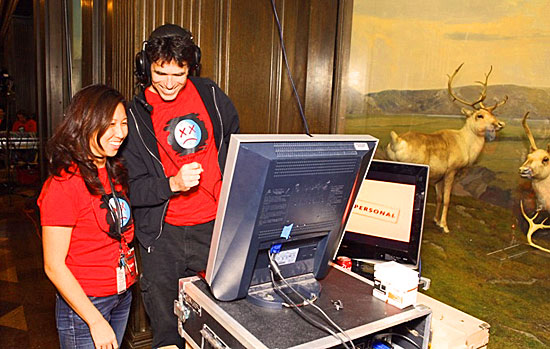
Su Oh at First Friday event, with museum tech expert Michael Wilson, right. Photo/Ryan Miller, Capture Imaging.
Meet Su Oh, the Natural History Museum’s in-house impresario.
Perhaps the only L.A. County employee whose job combines musical cool-hunting, scientific showmanship and a strong sense of theatrical occasion, Oh has been masterminding the museum’s “First Fridays” series for the past five years, presenting programs that combine top-notch lectures with cutting-edge live music.
Thanks in large part to Oh’s efforts, a species once endangered in the museum environment—the young adult—is approaching critical mass.
“At first, people were mainly coming for the concerts,” said Oh, Director of Education and Programs at the museum. “Now, they are coming for the lectures, too. The talks are really starting to rival the music in popularity.”
Oh, 40, formerly worked as an awards manager for the Recording Academy, which produces the Grammys. Five years ago, she decided it was time for a career change, but wasn’t quite sure how to use her entertainment industry experience to her advantage. She hadn’t had science-related experience since college, when she worked at Scripps Institution of Oceanography at the University of California, San Diego.
It just so happened that the Natural History Museum was seeking someone to take over First Fridays and work on boosting attendance. Oh tapped into her music industry experience to identify and book up-and-coming acts. The events began to pick up credibility among young people with an ear for innovative sounds.
Nowadays, the lecturers she schedules are rock stars in their own right, from the astronomer who “killed” Pluto to this week’s Pulitzer-winning presenter, Dr. Jared Diamond, widely known for his scholarship on everything from the birds of Papua New Guinea to the causes of global inequality. Diamond is perhaps best known for his book Guns, Germs, and Steel.
To Oh, great content is always the most important thing. Everything else follows.
“People may not know the bands and they may not know the scientists, but they trust that we are going to find good stuff for them, worth exploring at least,” she said.
Oh, whose duties also include outreach to schools and events like the annual Bug Fair, views First Fridays as “happenings” rather than just concerts or lectures. She has used projections, installation art and even a 14-foot T-Rex puppet to expand the audience’s experience while uniting them with the unique museum environment. Whatever the hook, it appears to be working. First Fridays increasingly draw large crowds, often nearing or reaching capacity.
Those crowds are not likely to dwindle soon. When Phase 1 of Exposition Light Rail Line opens on April 28, it will give the public a new route to the museum’s doorstep.
The stage is set for the Natural History Museum to celebrate its 100th birthday next year. Oh will take a more managerial role on First Fridays after this season, so she can focus more on the big picture. She envisions outdoor events that could host larger crowds while bringing nature lovers and conservationists into the fold.
That inclusivity is a hallmark of Oh’s programs. It’s also what drives her.
“I like connecting people, especially if they are not in each other’s normal realms,” she said. “The bigger gap there is to bridge, the more interested I am in it.”
You can see what the buzz is about at the latest installment of First Fridays this week.
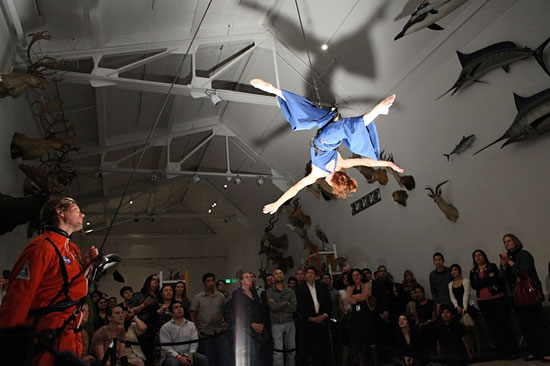
Project Bandaloop performs at the March 2 installment of First Fridays. Photo/Ryan Miller, Capture Imaging.
Posted 3/29/12
Eating it up on the Expo Line
March 28, 2012
They dubbed it the Pastrami Express. When the Red Line subway came to Langer’s MacArthur Park neighborhood in 1994, offering a convenient way for downtown workers to get their pastrami-on-rye fix, it touched off a transit-driven boom for the legendary delicatessen, family-owned since 1947.
After an inaugural weekend of free rides on the new subway, deli owner Norm Langer showed up Monday and was met with a miraculous sight: customers, by the hundreds.
“I had 500 people on a waiting list,” he recalled. It was a welcome turnaround for a business suffering at the time from demographic shifts and high crime in the neighborhood. “My light at the end of the tunnel was the Red Line,” he said. “If it didn’t open, we would have closed.”
Today, business is better than ever in a revitalized neighborhood, Langer said, continuing to marvel at the Red Line effect. “It’s phenomenal. And it gets better over the years because there are more lines that tie into it. We’ve had a great resurgence of our customer base because of it.”
Now a new generation of restaurateurs, business owners and cultural institutions is looking to another much-anticipated public transit project—the Expo Line—and hoping that the gravy train will soon be pulling up to their establishments, too.
Make that the chili, hot dog, fresh fish and cobbler train.
Earlez Grille is among those preparing for an influx of newcomers when the first Expo trains roll out on April 28.
“It’s a great thing,” said Cary Earle, who owns the establishment with his brother Duane and mother Hildred. The Grille’s location—beside the Crenshaw station and a few stops away from the University of Southern California—is prime, he said. “It’s going to give us a lot of USC students.”
First-time visitors should try the basics, he said: a beef hot dog with mustard and cooked onions, washed down with a Playa’s punch, a non-alcoholic mixture of red fruit drink and lemonade.
The restaurant, on the former site of Jack’s Chili Factory, also specializes in chili made from Jack’s original recipes. On a recent Expo Line test run for the media and elected officials, Metro CEO Art Leahy said he’s looking forward to eating there once Expo opens. “It will now be a hot downtown lunch spot,” he predicted.
Another potential hot spot is Mel’s Fish Shack on Jefferson Boulevard, a short walk from Expo’s Farmdale station, which is slated to open later in the spring, after the initial rollout.
“I pray that it will bring us a windfall of customers,” owner Georgette Powell said, sitting at the counter of her tiny eatery, where cooks like Jerry Rhodes fry up corn flour-dusted catfish, snapper and shrimp along with healthy innovations such as grilled salmon salad and tilapia wrap with dill sauce.
“I have felt isolated for many years” in terms of the accessibility of her location, said Powell, 44, who learned the business from her late father, Mel. “The train makes us more desirable.” Powell hopes eventually to expand Mel’s to other locations and perhaps start a community-based culinary school to train aspiring cooks in the “healthy soul food niche.”
Some, however, are skeptical about the train’s ability to deliver new customers.
“Will anybody walk over two blocks, when they’re traveling from Point A to Point B? I don’t think so,” said Carolyn McMillan, co-owner of The Kobbler King on Jefferson, near the Crenshaw station. Those who do make the trip, however, should try one of the savory cobblers like chicken or seafood, she said, with berry cobbler for dessert. “Peach and apple are good, don’t get me wrong, but I like the berries,” she said.
Initially, the Expo Line will travel between Metro’s 7th Street Center downtown and La Cienega/Jefferson. Some of its marquee destinations are big, internationally known venues—Staples Center, USC, the county Natural History Museum, the Coliseum. The California Science Center is expecting a “significant increase” in attendance, buoyed in part by the Expo Line and also by anticipated blockbuster shows devoted to Cleopatra, and, later, the Space Shuttle Endeavour.
But smaller venues, like the Lula Washington Dance Theatre near the Crenshaw station, are also hoping for a boost in visibility. “The main impact is that people will go by our place and see us,” said Executive Director Erwin Washington, who noted that many of the troupe’s dancers and students will also have an easier time getting to the theatre on the Expo Line.
At the California African American Museum, served by the new line’s Expo Park/USC station, director Charmaine Jefferson said staff at the admission-free museum would also have a better commute to work. In addition, having a light rail option should help overcome one of the major downsides of its location near the Coliseum: patrons who stay away on sporting event game days. “You’ll have guests who’ll say, it’s going to be a zoo; I don’t want to go there,” she said.
The rollout of the first phase of the Expo Line will culminate with the opening of the Culver City station at Venice and Robertson, expected this summer.
At Culver City’s quirky Museum of Jurassic Technology, archivist and administrator Hana van der Steur said the train will be a benefit for current visitors and supporters—as well as those who have yet to discover the collection of oddities and treasures.
“We’re basically ecstatic to have it,” she said. “We’re really hoping that people will take advantage of it. The museum is the kind of place that you really have to visit in order to get a good sense of it.”
Among owners of Culver City’s many eateries, there’s some uncertainty about what the station opening will mean for the area, already known as a dining destination for many on the Westside, said Ken Kaufman, the owner of Rush Street and City Tavern, who also serves on the board of the Culver City Downtown Business Association.
“We’re not sure of it. We know that the culture of L.A. is a car culture, and we don’t know how quickly people will adapt to using the train,” he said. “We don’t expect it to have a significant effect, but we hope we’re wrong.” He said a much bigger impact is expected four years from now—when Expo Phase 2 opens from Culver City to Santa Monica, giving traffic-challenged Santa Monicans a quicker route to dinner.
“As someone who takes reservations,” he said, “everybody knows that people who come from Santa Monica are always a half hour late.”
For a sampling of other attractions along the Expo Line route, check out Metro’s Destination Guide.
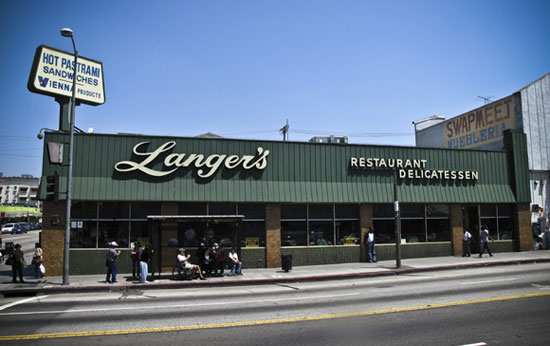
Langer's Deli says the Red Line saved its business in the days of high crime in the MacArthur Park neighborhood.
Posted 3/29/12
It’s a date: Expo to roll in April
March 23, 2012
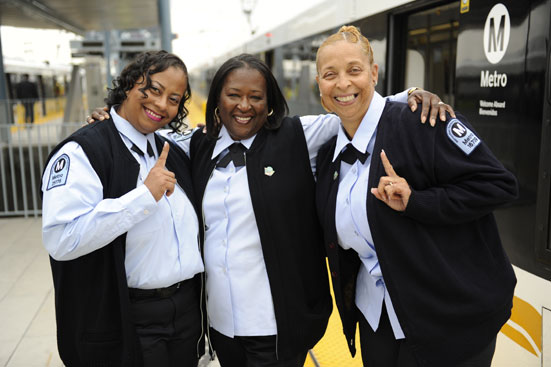
Train operators are ready to roll. From left, Narvolean Jackson, Carolyn Kelly and Sheila Celestain. Photo/Metro
After months of testing and delays, the much-anticipated Expo Line light rail will start carrying passengers on April 28, officials announced today.
Riders will be able to jump aboard for free during the line’s inaugural weekend, April 28 and 29. Metro Board Chair and L.A. Mayor Antonio Villaraigosa announced the opening this morning at a news conference with Supervisor Zev Yaroslavsky, Exposition Authority chair and Metro board member, and Metrolink chair Richard Katz.
“Some of us didn’t think we’d live long enough to see this day, but we’ve made it,” joked Yaroslavsky, standing on the platform of the new station at La Cienega and Jefferson. “This is the first light rail line, mass transit line, to serve the Westside of Los Angeles since the Red Car was dismantled in the 1950s, so this is a huge deal.”
After the announcement, the elected officials, Metro staffers and members of the news media hopped aboard Expo Line Train 246 for a standing-room-only ceremonial trip from La Cienega to downtown.
At first, the new line will run from Metro’s 7th Street Center downtown as far as the La Cienega station. Paralleling the notoriously jammed 10 Freeway, the Expo Line will open with 9 new stations, including USC, Western, Crenshaw and La Brea, and two stations shared with the Blue Line. In coming weeks, an additional station in Culver City is expected to open at Venice and Robertson, concluding the 8.6-mile Phase 1 of the project.
Meanwhile, Phase 2 is underway to extend the line 6.6 miles to 4th and Colorado in Santa Monica; it is expected to be completed in four years.
This interactive map shows how the entire 15.2-mile line will look when finished. It’s expected to eventually carry about 64,000 passengers a day, making it one of the most heavily-used lines of its kind in the country. The first phase is projected to carry about 26,000 riders a day.
“Every time we add a leg to our regional transportation network, it’s a whole that is bigger than the sum of its parts,” Yaroslavsky said. “When we finish this line to Santa Monica, you’ll be able to go from any part of Southern California to the beach. People who live near the beach will be able to go to any other part of Southern California. This line will now connect this community—the Crenshaw area, the Culver City area, ultimately Santa Monica—to the rest of the region.”
Testing on the $932 million first phase of the Expo Line has been underway since last fall, but the opening has been delayed several times to work out technical and logistical issues, including signal timing where the line intersects with the Blue Line at Washington and Flower.
Metro CEO Art Leahy said that problem has recently been worked out to allow trains to move through the intersection at regular intervals, without causing delays that could have rippled out throughout the system.
The Expo Line’s opening comes against a backdrop of rapid expansion of Los Angeles’ public mass transit network, once widely—and justly—derided as close to nonexistent.
In addition to the upcoming opening of the first part of the Expo Line, work has begun on the $1.5 billion Expo Phase 2, the northward extension of the Orange Line is nearly complete, final environmental documents for the Westside Subway have just been released and the Gold Line is expanding to Azusa, among other projects.
“There’s no city in the country, none, that is engaged in as ambitious an expansion of their light rail and subway system than L.A.,” Villaraigosa said.
Officials credited county voters will making it all possible by approving Measure R, the ½-cent sales tax for transit projects, in 2008.
“These are your tax dollars at work,” Yaroslavsky said.
Posted 3/23/12
For a preview of what’s in store, check out Supervisor Yaroslavsky’s Expo Line test ride in this video.
The Rock is a wrap—for now
March 10, 2012
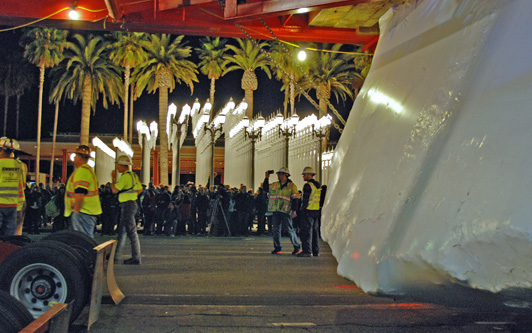
After its 4:30 a.m arrival, The Rock was parked for a photo-op in front of Chris Burden's iconic "Urban Light."
As crowds cheered and a loudspeaker blared Queen’s “We Will Rock You,” the Rock rolled into the Los Angeles County Museum of Art just before dawn on Saturday morning, riding down Wilshire Boulevard in its massive red transport like a 340-ton beauty in the Rose Parade.
“Fantastic,” said LACMA Director Michael Govan, unable to stop smiling as the focal point of “Levitated Mass,” the museum’s latest permanent installation, paused in front of the museum.
“Yahoo!” applauded Govan’s 7-year-old daughter, who was dressed in a pink coat and hoisted high on his shoulders.
“Magnificent!” breathed Alexandra Thum, a West Hollywood product designer who had worked her way through the crowd to get a curbside view. “It’s just so great to be here and see all the community together.” Around them, several hundred onlookers cried “Bravo! Bravo!” under the antique street lamps of another iconic LACMA masterpiece, Chris Burden’s “Urban Light.”
The reception capped an 11-day trip across 22 cities and four counties for the boulder, a hunk of granite the size of a 2-story teardrop that, in the weeks ahead, will be affixed atop a concrete channel, creating the illusion that it is levitating overhead. The work by Nevada earth artist Michael Heizer is scheduled to open in spring or early summer. (The famously reclusive artist was not on hand Saturday, but is expected to be in Los Angeles for the piece’s assembly.)
Although The Rock, as it came to be known, is only one component in the installation, it instantly became a media event itself because of the novelty and engineering involved in its move from its Jurupa Valley quarry in Riverside County.
Progressing at a stately 5 miles per hour and parked by day to minimize traffic disruptions, it inspired a marriage proposal in Glen Avon and a citywide block party in Long Beach, gawker’s block in Diamond Bar and pajama-clad sightseers near Expositon Park. In Rowland Heights, an accountant came home to discover it outside his bedroom window. So many people posed next to it for photos that, perhaps inevitably, it became an Internet meme for a digital moment.
While many thrilled at the spectacle, some decried its estimated $10-million expense, which has been covered entirely by private donors. “I think they should have spent $10 million on art programs instead of this rock,” said Patrick Taylor, a security guard and father of two who lives near Exposition Park.
Overall, however, museum officials were pleasantly surprised at the public reaction, which included a wave of fresh awareness for LACMA.
“When this started, I thought it would be much more controversial,” said Govan. “You know, ‘Is it art? Is it not art?’ But people mostly have just been fascinated and appreciative. And so many have learned about the museum from this experience.”
On Friday night—or, more accurately, Saturday morning—that appreciation was out in full, only-in-L.A. glory as thousands pulled all-nighters for the last leg of The Rock’s journey, up Western Avenue and along Wilshire Boulevard’s famed Miracle Mile.
Onlookers on foot and on bicycle snapped photos and videos and narrated the boulder’s slow-speed progress on hundreds of cell phones. Dogs barked. Tourists jumped out of buses and cabs to investigate the commotion.
A tall man dressed as Jesus and a shorter person dressed as a unicorn posed for pictures. Comedians worked the crowd. (“Have you seen my dog? It’s a ROCK-weiler!”) Further back in the crowd, actress Sharon Lawrence (“NYPD Blue,” “Desperate Housewives”) kept a low profile with her physician husband.
When the boulder slowed to make the painstaking turn in front of the Wiltern Theatre, a man waving an American flag ran out into the intersection, whooping. When the transporter was forced to stop, waiting for a tow-truck to remove a Dodge illegally parked in front of a karaoke bar on Wilshire, a dazed-looking young woman leaped into the street and either fell or tried to crawl underneath it. Shaken crewmembers escorted her back to the sidewalk and issued her a stern warning.
But for the most part, the mood was festive and communal, and the boulder’s movers—many of whom had walked alongside the megalith for most of the 105-mile route—were ready to celebrate by 4:30 a.m., when the procession paused in front of “Urban Light” for its final paparazzi moment.
“I got blisters on three of my toes,” laughed crewman Joe Schofield of Emmert International, who said on Saturday that he had been on foot, watching the rock, for more than 75 miles of the journey. Separate work crews ran ahead at each stop to clear the path of utility lines and landscaping. Workers from Time Warner Cable said they had moved lines in some 90 locations.
“Everybody has been clapping and cheering and connecting,” said Emmert General Manager Mark Albrecht, noting that, aside from that one incident with the young woman and a couple of mauled palm trees, the delivery was almost miraculously free of hitches. Around him, hard-hatted workers humbly ducked their heads as Los Angeles County Supervisor Zev Yaroslavsky and Los Angeles City Councilman Tom LaBonge thanked them.
Meanwhile, a crush of spectators rushed to touch the shrink-wrapped megalith with their fingertips until the transporter was put into gear again for the last yards of its journey, finally disappearing behind a gate on Fairfax Avenue and Sixth Street at 5:03 a.m.
Get ready to clear a path for 25,000
March 8, 2012
Whether you’re participating in it, watching it or trying to avoid it, if you live in Los Angeles it’s a good idea to know where the L.A. Marathon is headed. The annual race takes place Sunday, March 18. Here’s the lowdown:
The event will once again follow the “stadium to the sea” route, starting at Dodger Stadium and finishing by the Pacific Ocean. Check out the course map for the entire 26.2-mile route, or look at the “turn-by-turn” directions. The course will take participants through downtown L.A., Silverlake, Hollywood, Beverly Hills, Westwood and Brentwood, before ending in Santa Monica.
Rolling street closures will take place along the route, and additional street closures will be enforced to accommodate the event and all its accompanying fanfare. An overview of what to expect is here. There also will be lots of detours on bus routes.
Now is the time to register—after Friday, March 9, online registration closes and the prices go up for last-minute registrants at the event’s Expo, held on March 16 and 17. More than 25,000 brave souls are expected this year. The first place men’s and women’s finishers will receive $25,000, plus a new Honda Insight sedan. A $100,000 bonus will be given to the first person, regardless of gender, to cross the finish line, with the elite women runners beginning several minutes before the men. Some 220 “legacy” runners who have run the race all 25 previous times will be looking to make it 26 this year. If you’re doing the math, that’s 681.2 miles each over the past quarter-century.
If you just want to take in the spectacle, there’ll be plenty of entertainment along the route, including live bands, charity information booths and a Guinness World Record attempt involving 400 cheerleaders. You can get to the course via Metro Rail. On your mark…
Posted 3/8/12
Pluto-killing scientist talks
February 29, 2012

Poor little Pluto never saw it coming. Find out why Dr. Michael Brown pulled the plug on the one-time 9th planet.
Still miffed that Pluto’s not a planet anymore? The man responsible is coming to the county’s Natural History Museum to give his side of the story.
“I‘m ready for them to come in with rocks and throw their drinks and attack,” said Dr. Michael Brown, who’ll appear at the museum on Friday, March 2. “I know they are all sad about it.”
In 2005, Brown announced the discovery of Eris, an object larger than Pluto at the edge of the solar system. His team’s findings led the International Astronomical Union to revise the definition of “planet.” This demoted Pluto to a “dwarf planet,” causing an uproar among many who knew and loved the one-time ninth planet.
“Some of it is just funny,” Brown said of the backlash. “And some of it is just downright mean, which is almost funnier.”
Brown is a professor of planetary astronomy at the California Institute of Technology. His work has been featured in publications including the New York Times, The New Yorker and Discover magazine. In 2006, he was honored as one of Time Magazine’s “100 Most Influential People” and one of Los Angeles Magazine’s “Most Powerful Angelenos” for his discoveries. That same year, Wired Magazine named him one of the “Top Ten Sexiest Geeks.”
He told Wired in 2010 that even his 5-year-old daughter was perturbed by Pluto’s planetary downgrade. “She has learned from general discussions that I killed Pluto and that killing is bad. Therefore, I’ve done something bad, and so she’s kind of mad at me,” he said.
Brown, who’s also the author of the book “How I Killed Pluto and Why It Had It Coming,” hopes that by the end of the discussion people will be ready to lay down their torches and pitchforks.
“One of the things that will surprise people the most is how reasonable the decision to demote Pluto was,” he said. “I think they will leave and decide they should be mad at Pluto, not me.”
Brown’s talk, called “Why Pluto Had to Die,” starts at 6:30 p.m. It’s part of the museum’s “First Fridays” series combining science and innovative music. The programs aim to attract young and not-so-young adults to the museum, even though the field trips of their youth may be long past.
The tunes kick in at 5:30 p.m. with KCRW DJs Anthony Valadez and Chuck P. At 8 p.m. EMA takes the stage, combining a free jazz lyrical style with fuzzy, droning guitar rock reminiscent of Sonic Youth.
Zola Jesus, the night’s headliner, is a self-made, up-and-coming electronic pop musician at the age of 22. Her compositions pair trance-inducing electronic sounds with haunting, almost-mournful vocals. She goes on at 9:15 p.m. amid the dioramas of the North American Mammal Hall.
General admission to all of it is $18, and free for Universityof Southern California students. The museum is located at 900 Exposition Boulevard in Los Angeles. Parking is $10, or plan to get there with Metro. While advance tickets are sold out, don’t worry—same day tickets will be available at the south entrance starting at 5 p.m.
Posted 2/29/12
Finally, “The Rock” meets the road
February 29, 2012
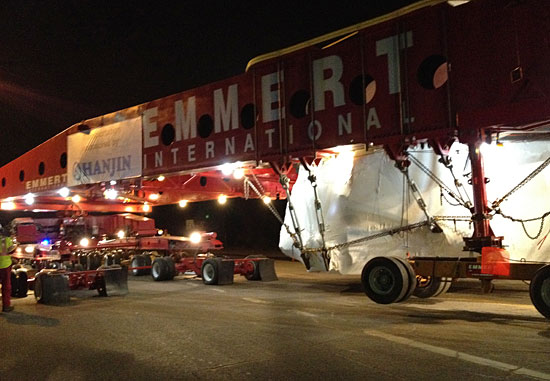
The Rock begins its nine-day journey to LACMA, where it will be used in Michael Heizer's "Levitated Mass."
With a round of applause and two mighty blasts of a truck horn, The Rock finally hit the road at 10:37 p.m. on Tuesday in what may be the most talked about slow-speed odyssey since O.J. Simpson’s Bronco snaked through the Southland’s streets.
The 340-ton boulder that is the centerpiece of “Levitated Mass,” Michael Heizer’s new LACMA installation took seven minutes just to make it out of the Stone Valley Materials Inc. quarry in Riverside County.
A crowd of several hundred cheered and shivered as the behemoth began its epic journey. Covered in white shrink-wrap to ward off taggers, it rode on a massive red transporter and looked, under the vehicle’s bright lights, like a well-lit iceberg.
“This is a once in a lifetime experience, to see something like this,” said Stan Ortman of Chino Hills, who spotted the boulder on his way home from work and stopped. “This has been here for like 20,000 years, and now it’s art.”
The Rock, as it affectionately came to be known, has been waiting for what seems like eons to head out to LACMA, where it will be positioned over a concrete trench in a manner that will make it look as if it is levitating.
That Thursday night’s festive send-off even happened is a bureaucratic miracle of sorts. Although millions of dollars in transportation costs are being underwritten by corporate donor Hanjin Shipping, the move required delicate and sometimes contentious negotiations with 22 cities and four counties. As early as Tuesday morning, some municipalities were still demanding various concessions from the museum in exchange for permits.
For the next nine days, The Rock will be cradled on its 299-foot-long, 27-foot-wide steel carriage as it travels on surface streets at speeds of less than 5 mph. Crews of workers will rush ahead to make sure utility and power lines are kept clear.
The Rock reached its first stop before dawn at a wide-open strip of private property at Mission Boulevard and Bellegrave Avenue in Glen Avon. It will spend all of Wednesday there before setting off in darkness on its next leg, which, if all goes according to plan, will get it as far as Mission Boulevard and Grove Avenue, near LA/Ontario International Airport.
(For a full LACMA “Gawker’s Guide” to The Rock’s trip, click here.)
On Tuesday night, several hundred people came by during the evening to bid The Rock bon voyage, including LACMA Director Michael Govan, Supervisor Zev Yaroslavsky, Jurupa Valley Mayor Laura Roughton, and Dan Johnston, who, as project manager for the quarry’s former owner, sold the boulder to Heizer.
Govan said that, when Heizer first set eyes on granite boulder, which had been dynamited from the side of the mountain, “he called me… and said it was the most beautiful rock he’d ever seen.”
Although Heizer, who is famously reclusive, was not in attendance Tuesday, Govan said he’d seen him earlier in the day at the artist’s home in Nevada. “He said there was nothing he could do to help move the rock,” Govan explained, “so he wouldn’t be here. But he’s excited. When we first started this, we weren’t sure it would actually happen. The engineering, the organization, all the permissions—there were a lot of doubters. But now it’s happening, and it’s going to be a real gift to the public. It’s going to be great.”
The crowd tended to agree.
Daniel Ponti, a Glen Avon photographer, said he had been “waitin’ months for that darn thing to move,” and checking its progress daily. Saul Gomez, 14, of Sunnyslope, said his father had alerted him to The Rock’s presence and sent him to look with his mom and his sister Samantha. “I’ve never seen anything like it,” the boy said. “It’s huge!”
Others were as amused as they were awestruck.
“Pretty big rock, huh?” observed Dave Sharp of nearby East Highland, a union employee whose wife, Leslie Hubbs, said she was the niece of the quarry’s former owner. “I think it’s crazy. It’s great, but it’s nuts.”
Stephen Vander Hart, the quarry’s current owner, said the boulder had been loaded since December and ready to roll since Saturday morning. All week, he said, bystanders had been coming by to check it out.
As the sun set Tuesday, commuters and neighbors gathered to pose with the boulder and buy Southern-style barbecue from an enterprising local chef. “We’re re gonna miss it,” said Vander Hart. “It’s pretty impressive. I think people are gonna get a kick out of seeing it out there on the road.”
The Rock will travel only at night. In addition to the first two stops in Riverside County, it will stop in Diamond Bar, Rowland Heights (it will be across the street from Pathfinder Community Regional Park both Saturday and Sunday), La Mirada, Lakewood, Long Beach’s Bixby Knolls neighborhood, Carson, and Los Angeles (near Exposition Park).
It will rest during the day and arrive at LACMA on Friday sometime before dawn. There, it will be positioned over the other half of Heizer’s artwork—a massive concrete trench on the Resnick Pavilion lawn.
Posted 2/29/12
Embracing the dark side in rural L.A.
January 24, 2012
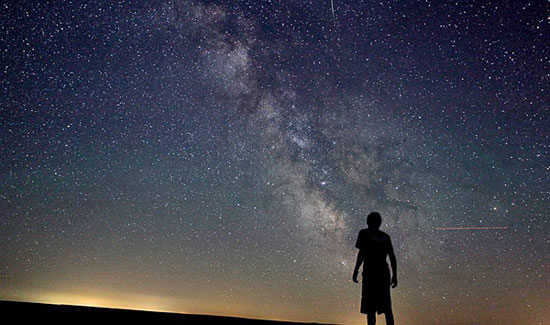
The county's new "dark skies" law may not lead to this kind of view, but it's certainly a step forward.
“Light blight.”
That’s Kim Lamorie’s term for the spectacle that occurs every time an urbanite moves to one of the rural communities near her Calabasas home. The sun sets, the black night settles over the Santa Monica Mountains, and before long, “their houses and yards are massively lit up like crazy,” says Lamorie, president of the Las Virgenes Homeowners Federation.
“It’s how you can tell when somebody’s new to the rural area.”
Eventually, she says, the newcomers come to realize that they don’t need all that security lighting and that bright lights confuse and even threaten the nocturnal animals that share their wilderness. But in the meantime, she says, all that fear of the dark can ruin one of the best aspects of mountain living:
“I can step outside my door at night,” she says, “and see the stars.”
On Tuesday, after more than a year of preparation, the Board of Supervisors restricted outdoor lights in rural Los Angeles County in an attempt to curb light pollution in such unincorporated areas as the Antelope and Santa Clarita valleys and the Santa Monica Mountains.
The new regulations create a Rural Outdoor Lighting District that encompasses those and other sparsely populated parts of the county and requires that lights on barns, corrals, ball fields and other such facilities be shielded so that they face downward, not outward and upward. It also requires outdoor lights, such as those on patios, be subdued enough so that they don’t “trespass” onto neighboring properties.
Although a handful of public safety facilities, such as those operated by the Sheriff and Probation departments, will be exempt from the restrictions, most rural landowners—including the county—must comply with the requirements. That mandate was stressed in a motion by Supervisors Zev Yaroslavsky and Michael D. Antonovich after the Department of Public Works issued rough, last-minute estimates indicating that the cost of replacing lights on the agency’s rural buildings would be so high that would be so high that they would have to dip into funds otherwise reserved for road projects.
“The Department of Public Works should find cost effective ways to comply with the ordinance like every other stakeholder, and they should do so out of their existing . . . budget,” Yaroslavsky and Antonovich said in their motion, calling the estimates “not credible.”
The new rules give county departments six months to report back on how they’ll comply. Homeowners will also get an initial grace period, after which enforcement will be based on complaints. For commercial and recreational facilities, such as ball fields and businesses, lights must be turned off either an hour after a game’s end, at the close of business or at 10 p.m., whichever is the latest.
Rural homeowners applauded the ordinance, championed by Antonovich and Yaroslavsky.
“Out here in the country, most people want to see the stars. And if your neighbor’s got tons of lights, and they don’t shut them off, it really does cause a problem,” said Wayne Argo, who lives in the Antelope Valley on three acres near the Angeles National Forestand who is director of the Association of Rural Town Councils.
“A couple of years ago, we had problems in Leona Valley with people using arena lights on their horse property and not turning them off at a reasonable time,” he said. “For the people in the area, it was like having a baseball field or a football field next door.”
As civilization has encroached on once-unspoiled horizons, city lights have eclipsed more and more of the night sky. Already, astronomers say, the Milky Way has become invisible in two-thirds of the country; after the 1994 Northridge earthquake, the Griffith Park Observatory reports, frightened Angelenos called when the power went out, wondering what the weird, silvery shimmer was in the night sky.
“Some thought it was the end of the world,” according to the observatory’s website. “It was, in fact, the stars.”
Some of the first calls for a curb on light pollution came from stargazers in Arizona. The city of Flagstaff passed one of the first anti-light pollution ordinances in 1958 to stop searchlights from impairing the work of astronomers at Lowell Observatory, where Pluto had been discovered. Then, in 1972, the city of Tucson began requiring city lights to be pointed downward to protect the Kitt Peak National Observatory.
By the mid-1980s, a state statute had been enacted in Arizona, and in 1988, astronomers in Tucsonfounded the International Dark-Sky Association (IDA) to advocate on the issue. The IDA now has 58 chapters in 16 countries, helping draft model light pollution ordinances for communities.
In California, the city of San Joseswitched to low-pressure sodium lights in the 1980s to protect the nearby Lick Observatory; San Diego used regulations to dim the skies for the Palomar and Mount Laguna observatories as well.
In recent years, however, the dark skies movement has moved beyond astronomy to touch on environmental, health and lifestyle questions. The loss of darkness has, for example, also affected the feeding, mating and migration habits of wildlife from bats to sea turtles. Meanwhile, medical researchers have uncovered links between the incidence of breast and prostate cancer and exposure to artificial light at night.
In 2002, the city of Calabasas, which abuts the unincorporated Santa Monica Mountains, passed its own local light pollution ordinance, largely to preserve the rural character and local ecology of the community. According to a recent issue of the Las Virgenes Homeowner’s Association newsletter, in the last four years, the city has fielded only about nine complaints of light trespass, all involving commercial night lighting.
Both Lamorie and Argo hope further public education also will be a big part of the county’s light enforcement. And for those who are still not convinced of the new law’s value, Argo has a suggestion.
“You wait ‘til a half-hour or so after sunset, then sit down in a lawn chair, and lay your head back, and look straight up,” Argo said. “You can see satellites. You can see all the constellations. On a clear night, you can almost reach up and touch the Milky Way.”
Posted 1/24/12
The new kids on campus
December 1, 2011
 Throughout his 15 years, Mauricio hasn’t had much to celebrate, not with a turbulent family history that has led to a life of foster care and self-doubt. So when the call came, he couldn’t contain himself. “I was jumping up and down,” recalls the impish teenager.
Throughout his 15 years, Mauricio hasn’t had much to celebrate, not with a turbulent family history that has led to a life of foster care and self-doubt. So when the call came, he couldn’t contain himself. “I was jumping up and down,” recalls the impish teenager.
Mauricio had been informed that he’d been picked to participate in an unprecedented summer experiment on the UCLA campus, one that aims to infuse ambition and confidence into a group of kids who rarely go to college mostly because there’s been no one to help them get there.
Mauricio says he packed his suitcase a full month before the start of the intensive, five-week program and arrived so early on the first day that the former sorority house where he and the others would be living was still empty. “I was just so proud,” he says.
In a sense, however, the occasion represented more of a start than a finish. The students will continue to meet monthly on the Westwood campus and, if sufficient funds can be raised, will return in subsequent summers, along with new crops of recruits that will swell the program’s ranks and someday, hopefully, turn them all into full-fledged college students.
On Friday, that pride was shared by plenty of others—but, most importantly, by the 24 inaugural graduates of the First Star UCLA Guardian Scholars Summer Academy, the first such academic program of its kind for foster kids and others under the jurisdiction of child welfare officials. The youngsters, all of whom will be entering 9th grade, were honored during a commencement ceremony highlighted by one girl’s rousing exclamation: “I’m a Bruin now!”
In a sense, however, the occasion represented more of a start than a finish. The students will continue to meet monthly on the Westwood campus and, if sufficient funds can be raised, will return in subsequent summers, along with new crops of recruits that will swell the program’s ranks and someday, hopefully, turn them all into full-fledged college students. (Click here for a video on the program produced by Supervisor Yaroslavsky’s web staff.)
The program’s supporters say they’re determined to shatter the shameful statistics surrounding foster children, huge numbers of whom end up homeless and incarcerated in the years after their 18th birthdays, when they “age out” of the system. Only a fraction of them—an estimated two percent—continue their educations beyond high school.
“You can argue that college is their best possible ladder to leave behind a bad childhood and make it into a happy adulthood and a productive one that will not be a burden on the state, that will be something of high accomplishment,” says media executive Peter Samuelson, a driving force behind the program through his non-profit group First Star, which joined forces with UCLA and the County of Los Angeles.
“There’s nothing the matter with these children. Not one of them,” he says. “All of these kids can go to college. The issue is that nobody ever told them they could. How dumb is that? Who’s failing here, the kids or the grownups?”
The Summer Academy was designed to jump-start the participants’ collegiate careers and expose them to the rigors and culture of university life at a crucial juncture, just as they’re entering high school.
 Each earned four college credits through a challenging mix of classes tailored to their educational, psychological and recreational needs. Those included math, literacy, social media, tai chi, cooking and life skills, where they learned meditation and conflict resolution. In the evenings, they were visited by an impressive series of speakers, including National Hockey League great Luc Robitaille, whose Echoes of Hope charity targets the needs of at-risk Los Angeles foster youth.
Each earned four college credits through a challenging mix of classes tailored to their educational, psychological and recreational needs. Those included math, literacy, social media, tai chi, cooking and life skills, where they learned meditation and conflict resolution. In the evenings, they were visited by an impressive series of speakers, including National Hockey League great Luc Robitaille, whose Echoes of Hope charity targets the needs of at-risk Los Angeles foster youth.
And then there were the field trips to, among other places, Disneyland, Skid Row and celebrity Chef Mario Batali’s restaurant, Mozza, where one teenage girl sheepishly confessed to eating nine slices of the establishment’s famed pizza. (The Batali Foundation also contributed money to the Summer Academy, along with the Stuart Foundation, College Board, Sage Publications and Hasbro Children’s Foundation.)
“It scares you in the right way,” Tiffany, 14, says of the program’s morning-to-night regimen. “You know what you’re being pushed to do. A lot of people say, ‘Oh, I want to go to college.’ But until you actually see college kids and what they do and their level of intelligence, it’s hard to say yes.”
Initially, 30 students were selected for the program. But six boys were sent home in the second week for bad behavior, a wrenching decision for all involved. Still, academy officials had no intention of joining the long line of adults who’ve abandoned or given up on such boundary-pushing kids, a reflection of the program’s commitment to—and understanding of—its charges.
Program leaders have remained in contact with the remorseful teens and have held out the promise that they can participate in the group’s monthly UCLA gatherings and, if all goes well at home and in school, they’ll be able to join next summer’s class of young scholars.
“They’ve been told, ‘You are fine young men.’ They’ve all been given hope and a shining pathway of behavior to get themselves back in,” says Samuelson, who raised $305,000 for the summer academy. “When we get these six young men back into the academy, they will count amongst our greatest successes.”
Day to day, the program is run by a seemingly unflappable educator and former vice principal of an elementary school in a tough New Jersey neighborhood. “I fell in love working with students who felt that nobody else cared about them,” says academy director Wally Kappeler, 37, the father of an eight-week-old son.
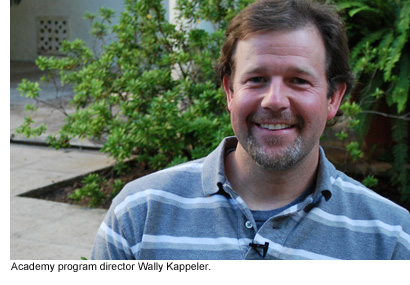 He says that, for him, the biggest surprise of the summer program was how quickly the kids were willing to open up, especially after an evening session when one of them broke the ice and shared the story of his mom’s death. “Here,” Kappeler says, “they have an opportunity to be heard.”
He says that, for him, the biggest surprise of the summer program was how quickly the kids were willing to open up, especially after an evening session when one of them broke the ice and shared the story of his mom’s death. “Here,” Kappeler says, “they have an opportunity to be heard.”
Kappeler says another boy, shy and self conscious about his weight, would mostly keep to himself like “an outcast” until he was given a special daily job of locking a rear door at their three-story Hilgard Avenue house after deliveries by the caterer.
“He felt so proud that this was his responsibility that he volunteered for all kinds of jobs,” Kappeler says. “He volunteered to take the trash out to the dumpster and wipe the tables and make Kool-Aid for the entire group. And it became contagious…It’s amazing the inspiration that he’s been to us, coming out of his shell and taking a leadership role without saying much of anything at all.”
Because of such breakthroughs and the upbeat bonding between the youngsters, it’s easy to forget the circumstances that brought them to UCLA—the abuse and neglect, the revolving placements in new homes and schools, the philosophies of life that have evolved from the sadness of their situations.
Listen, for example, to Eddie, a soft-spoken 15-year-old, who confides: “Too much happiness could actually hurt you. You just need the right amount because I don’t want to get hurt anymore. Right now I’m not really in the mood for situations like love and happiness. I really want to succeed in my life.” Eddie says he’s determined to be the first in his family to attend college.
Or hear what Thalia, 14, has to say as she speaks for the many who’ve been betrayed by parents. “Even if they’ve done something bad to you, they’re still your blood and they’re part of you and you love them no matter what. And you will always forgive them, even though you’re mad at them at the moment. But they’re always going to be in your heart.”
Kappeler says his heart aches when he hears the kids talk like this. “The emotional baggage they’re holding onto is the stuff that most adults would use as an excuse to give up on life.” Instead, Kappeler says the academy is teaching students to harness the power of their narratives through writing, video and social media so they can become more effective advocates for themselves.
“I want them to feel like they can make a difference in this world just by being who they are and getting their story out,” he says, noting that each was given a laptop and video flip-cam to keep.
To guide and inspire the participants along the way, the program was staffed by peer counselors and resident assistants who are UCLA students and, for the most part, former foster youths themselves.
One of was senior Julian Ramirez, 21. As a youngster in San Jose, he endured a home fraught with addiction and violence. “One day my dad would say, ‘Let’s go fishing.’ The next, he’d be beating us with the fishing poles.” Under a mop of dark hair, Ramirez says he’s still got a scar from a concrete slab his father smashed against his head. Child welfare authorities, he says, repeatedly removed him and his siblings from his parents.
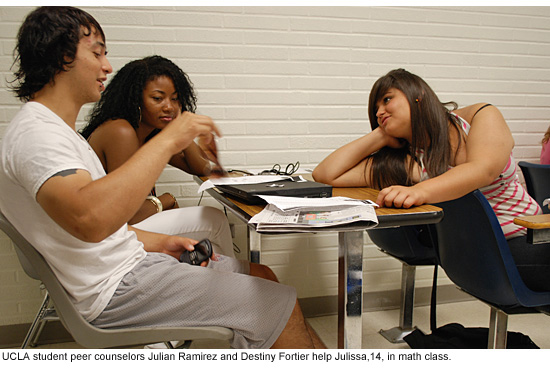 In his senior year of high school, Ramirez says it was “do or die” and he began to excel, achieving a 4.0 and becoming the captain of the wrestling team. He went to a community college in Cupertino—despite several months of homelessness—and then transferred to UCLA, where he joined the UCLA Bruin Guardian Scholars, a campus association of former foster youth. “What mattered to me most,” he says, “was that I wanted to stay on track with my peers. I didn’t want to be slower than them. And I wanted to prove to myself I was capable.”
In his senior year of high school, Ramirez says it was “do or die” and he began to excel, achieving a 4.0 and becoming the captain of the wrestling team. He went to a community college in Cupertino—despite several months of homelessness—and then transferred to UCLA, where he joined the UCLA Bruin Guardian Scholars, a campus association of former foster youth. “What mattered to me most,” he says, “was that I wanted to stay on track with my peers. I didn’t want to be slower than them. And I wanted to prove to myself I was capable.”
He says he hopes that his empathy and success—and that of the other student staffers—proved useful to the young teenagers in the summer program.
“I’ve been through a lot,” he says. “I know how it is to be 14, angry and not have anyone to talk to.”
In fact, the young participants told UCLA researchers late last week that the student mentors were “really impactful for them,” especially in the way “they talked about their journey through foster care,” says Associate Professor Todd Franke of the School of Public Affairs/Social Welfare, who’s conducting a longitudinal study of the students’ progress.
Franke says that, although it’s too soon to say much definitively about the program, there are some encouraging signs, based on a comparison of initial interviews with the teens and another series conducted on the eve of their commencement.
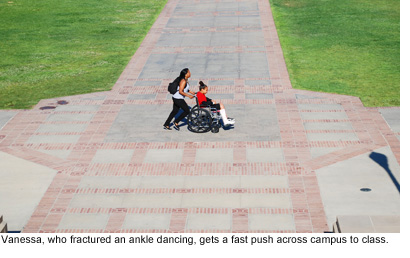 From the beginning, Franke says, virtually all the students said they wanted to go to college. “But in the past five weeks, the vast majority now see it as a much more realistic goal. It moved them further down the continuum to think that this is a real possibility for them.” They got a sense of the workload, learned that they’d likely be eligible for financial aid and came to believe that they’d have a strong campus support group to help get them through the rough patches, according to Franke. “The process,” he says, “was demystified.”
From the beginning, Franke says, virtually all the students said they wanted to go to college. “But in the past five weeks, the vast majority now see it as a much more realistic goal. It moved them further down the continuum to think that this is a real possibility for them.” They got a sense of the workload, learned that they’d likely be eligible for financial aid and came to believe that they’d have a strong campus support group to help get them through the rough patches, according to Franke. “The process,” he says, “was demystified.”
On Friday, commencement day, an assortment of foster parents, legal guardians and relatives gathered around dozens of tables inside UCLA’s Tom Bradley International Hall. There, they heard speeches about the heart and hope of the young Summer Academy participants. Among the officials who addressed the teens and their caregivers was Los Angeles County Supervisor Zev Yaroslavsky, whose office helped facilitate the program through the Department of Children and Family Services.
He told the teenagers that, on some level, he could identify with their struggles. He said his mother died when he was 10 and that his father worked in the evenings, which meant there was no one to help him with homework or keep an eye on him at night.
“The thing that you have that most college students don’t have is that by the time you get ready to come into college, you probably will have gone through the toughest part of your life,” said the supervisor, a UCLA alumnus. “And while you may not appreciate that, you should embrace that experience, treasure that experience, because it’s going to toughen you up. It’s going to make you tough enough to confront whatever comes along your way, when you’re in college and after that.”
After the speeches were done and the two-dozen scholars received their graduation certificates—along with a standing ovation—it was time for them to leave this place of grownup aspirations and youthful good times. There were lots of hugs and tears, even though they’ll all be together again on campus in a month.
“I feel proud but at the same time I feel sad,” explained Mauricio. “I feel like this is my house.”
Video and photos by Supervisor Yaroslavsky’s web staff.
Posted 8/7/11




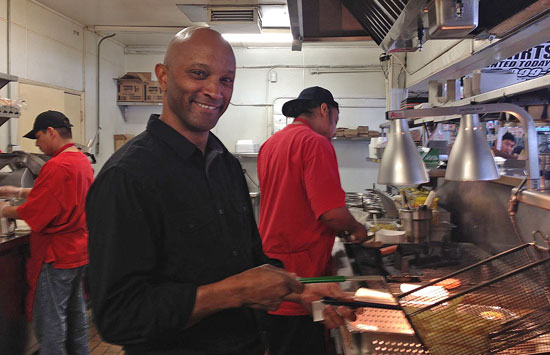
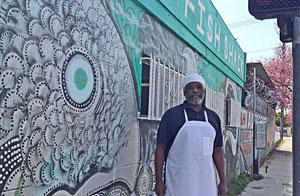
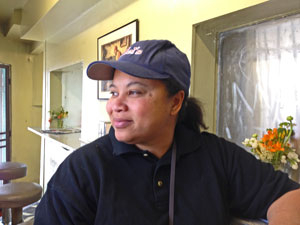
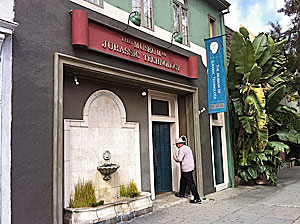
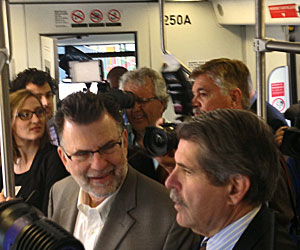
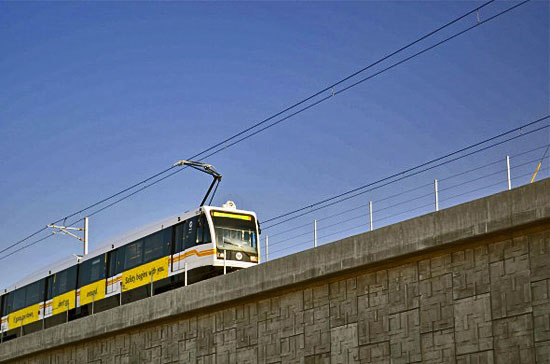
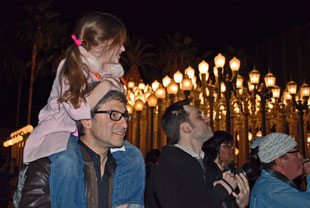

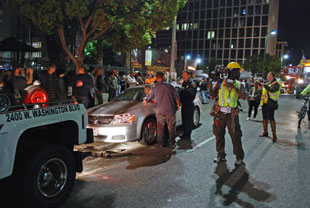

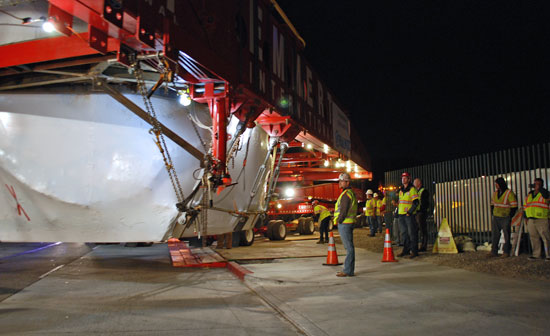
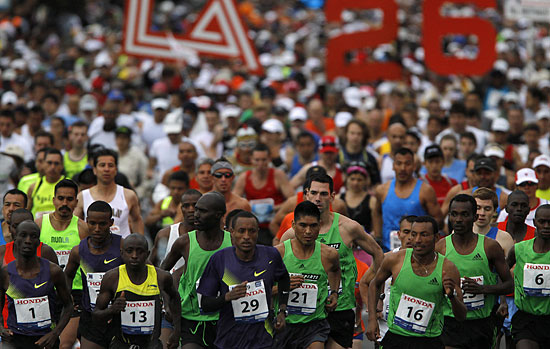
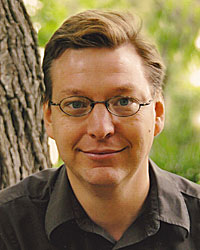
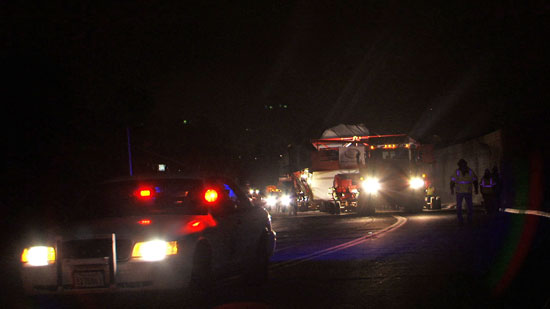
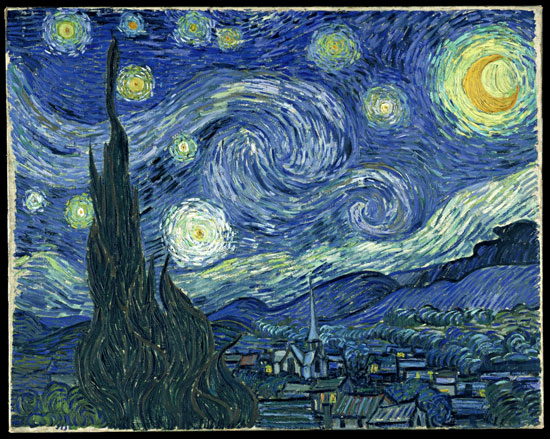







 405 bridge work causes a stink
405 bridge work causes a stink

